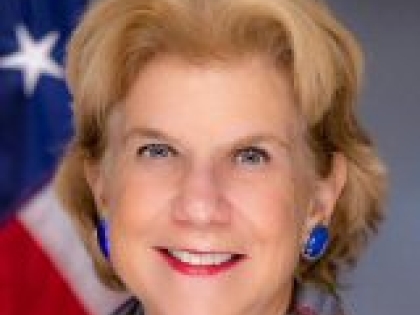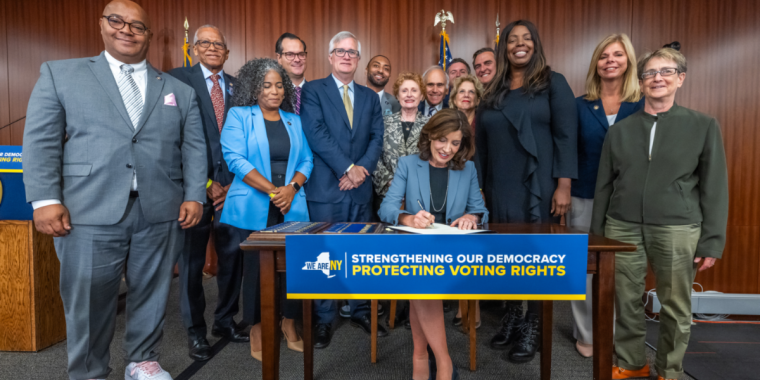
Time: Why I’m Focusing On Getting More Women in Public Office
Melinda French Gates
June 23, 2023
In 1976, Anna Belle Clement O’Brien, known as the first lady of Tennessee politics, ran for office on the slogan “A woman’s place is in the House… and the Senate too.” That idea—that women deserve a role in making decisions, controlling resources, and shaping policies and perspectives—is at the center of my work as an advocate for women and girls. And it’s why I’m stepping up my investments in systems-wide efforts to build women’s political power.
When the Supreme Court overturned Roe v. Wade in June 2022, it was yet another reminder that we still live in a country where decisions are made for women instead of by them. Only one in three state legislators in the U.S. is a woman. At the federal level, it’s closer to one in four. In the House of Representatives, there are more men named “Mike” than women chairing committees. There are more than 16 million Black women in this country—and exactly zero in the United States Senate. There has never been a Black or Indigenous woman elected governor.
In a democracy, representation is a vital principle. But more than that, it’s the bedrock of good governance. While no one would claim that women are a monolith who support any one party or agenda, there is evidence that women govern differently, working more collaboratively across party lines and introducing legislation on issues that have historically gone unaddressed. That’s why I’m convinced that having more women at all levels of government will make government work better.
I’m also convinced there’s a realistic path to getting there. As a philanthropist, I’ve always been interested in catalytic philanthropy, areas where strategic investments of attention and resources can unlock outsized gains. When it comes to building women’s political power, my team at Pivotal Ventures and I believe one of those catalysts is state legislatures.
It’s not just that there are so many seats at the state level—more than 7000 of them—setting a broad stage for transformative progress. It’s also that state legislatures are powerhouses of American policymaking. They control $2 trillion per year in spending and write the laws that govern people’s day-to-day lives on issues ranging from voting to reproductive rights to schools.
What’s more, serving in state legislatures is often a launchpad to higher office. Half the women serving in Congress today previously served in statehouses. Electing more women to these seats and supporting them as they advance their legislative agendas deepens the bench of women qualified to serve at the highest levels of government—and can pay dividends for decades.
The challenge is that running for office is a demanding, unpaid, time-intensive, sometimes even dangerous job that is often made still more difficult by how hard women—and particularly women of color—have to work to convince donors and party gatekeepers that they are viable candidates worth investing in. On such an uneven playing field, it helps to have external support. One organization I’ve partnered with, Vote Run Lead, trains women on the skills they need to run for office, from overcoming fundraising deficits to dealing with threats and online harassment. Last year, candidates who had previously participated in Vote Run Lead’s program had a win rate of 68 percent, including the first three Black women ever to serve in Minnesota’s state senate.
Ultimately, though, we can’t just keep pushing women into a broken system: We need to fix the system, addressing the full range of structural barriers that keep our government from looking like the people it’s intended to serve.
This was driven home for me last month when I sat down with a group of women serving in the New York legislature. One of them, Sen. Shelley Mayer told me that when she first considered running for office in the 1980s, three women assembly members told her it simply wasn’t possible for a mother of young children. Sen. Samra Brouk, the first Black woman elected to the legislature from Upstate New York told me she is one of only two New York state senators in the last 50 years to give birth while in office. She described how commuting to Albany for legislative business required choosing between leaving her baby at home with her husband, hoping she’d pumped enough breastmilk to last until she was back, or bringing the baby to the capital and scrambling to find child care without knowing what time floor debates would end each day. She’s making it work, but the amount of effort it takes is enough to deter many others. Only 5 percent of state legislators are mothers with kids under 18, compared to 18 percent of the U.S. population as a whole.
If the job requirements for such an important job functionally disqualify mothers of young children, maybe it’s time to update the requirements. There are a number of practical changes that could open the door to more women lawmakers, including such commonsense reforms advanced by our partner Vote Mama, like allowing representatives to attend hearings and vote virtually. Similarly, offering lawmakers paid family and medical leave and permitting candidates to use campaign funds to pay for childcare would make it easier for more mothers (and fathers!) to run for office. By getting rid of outdated rules left over from an era when women lawmakers were the exception, we can help make women lawmakers a new norm.
The tide is starting to turn. Today, there are more women in Congress than ever. Last fall’s election set new records for the number of women governors and state legislators. Let’s make sure they’re at the forefront of a movement to build women’s political power at all levels of government—not only because women belong there but because of how badly we need them there.
Read the article here: https://time.com/6289240/melinda-french-gates-women-running-for-office/
Share this Article or Press Release
Newsroom
Go to NewsroomNY Daily News: N.Y. can fight back against flooding
September 30, 2023
WENY News: New law requiring notice of unemployment benefits
September 28, 2023
